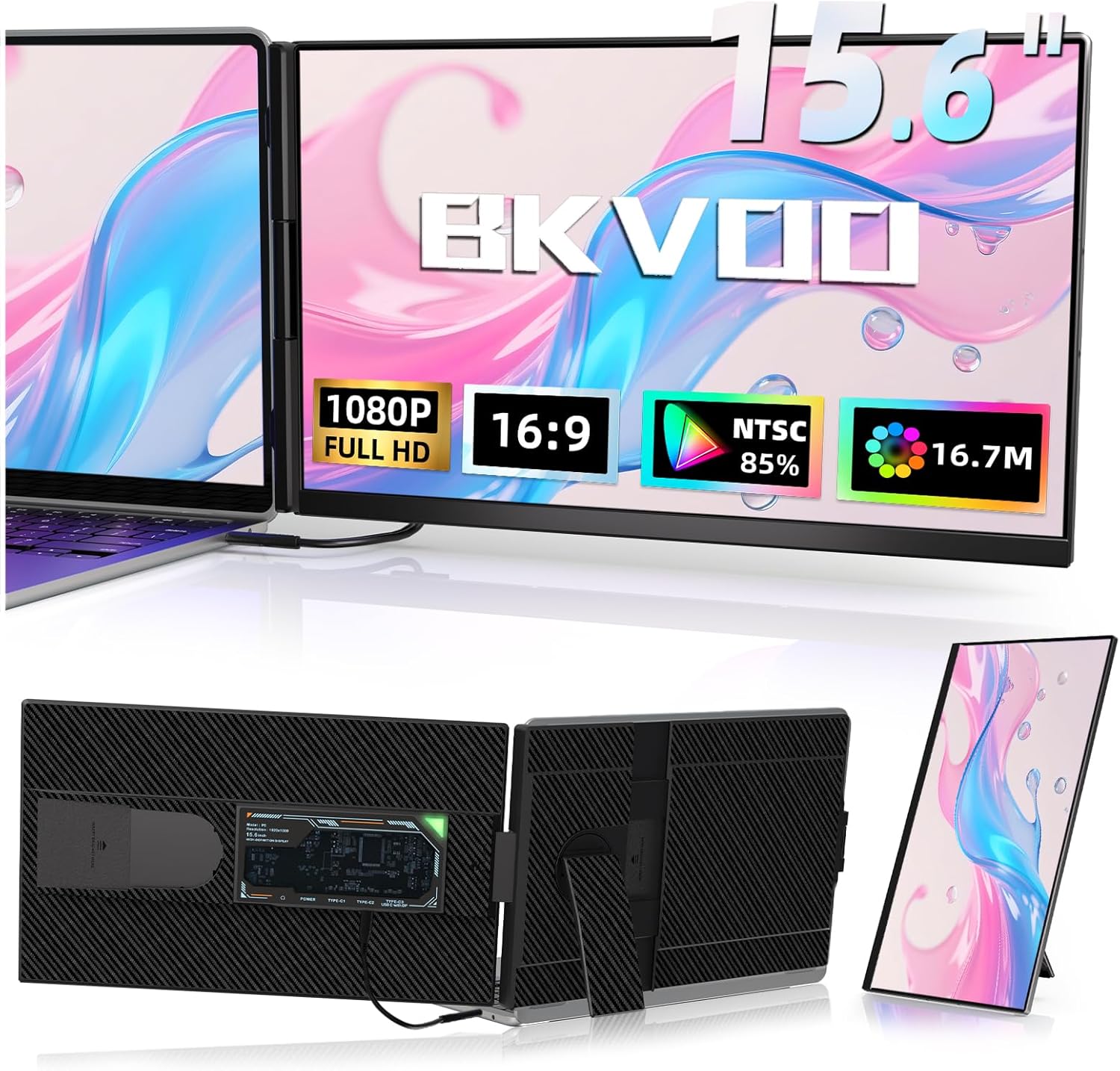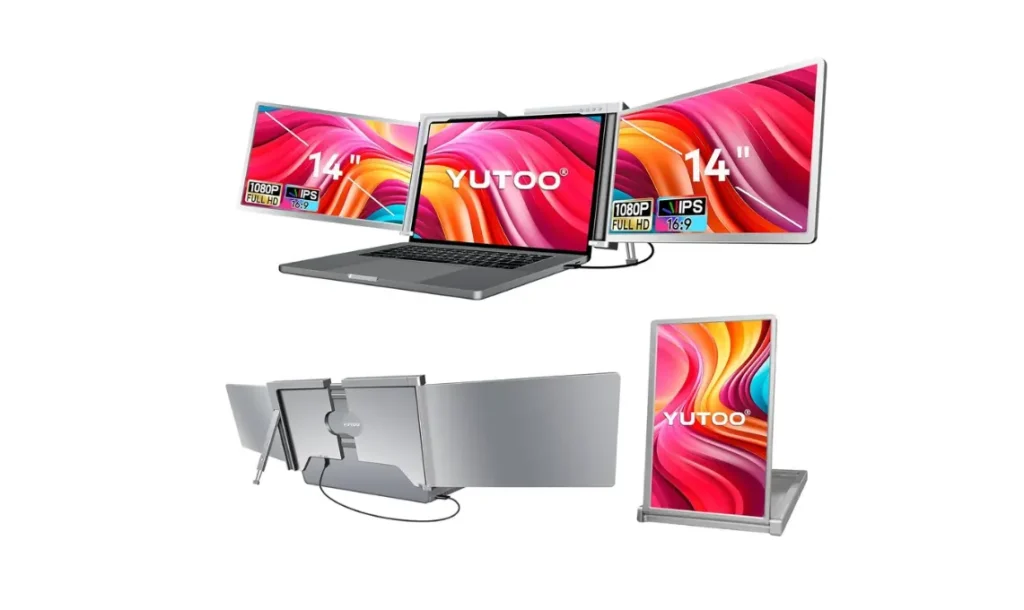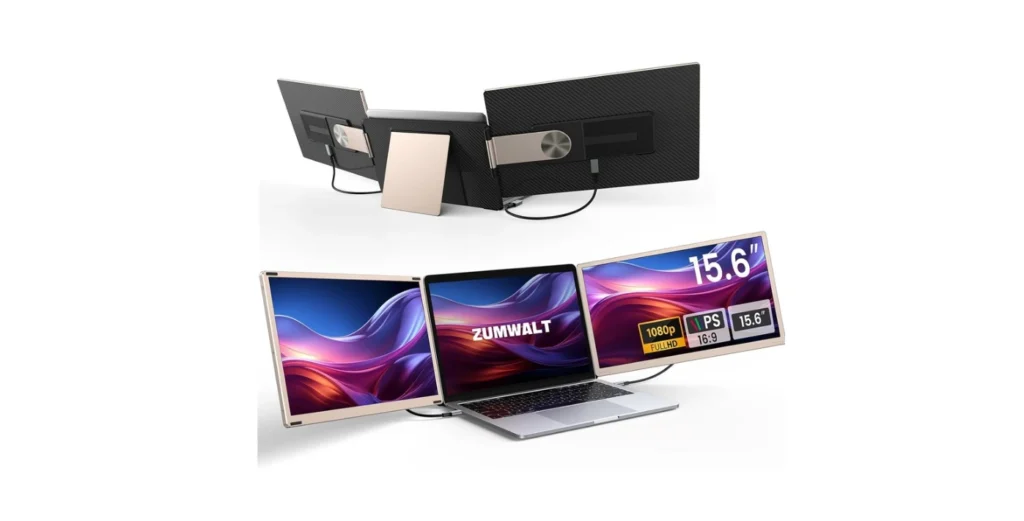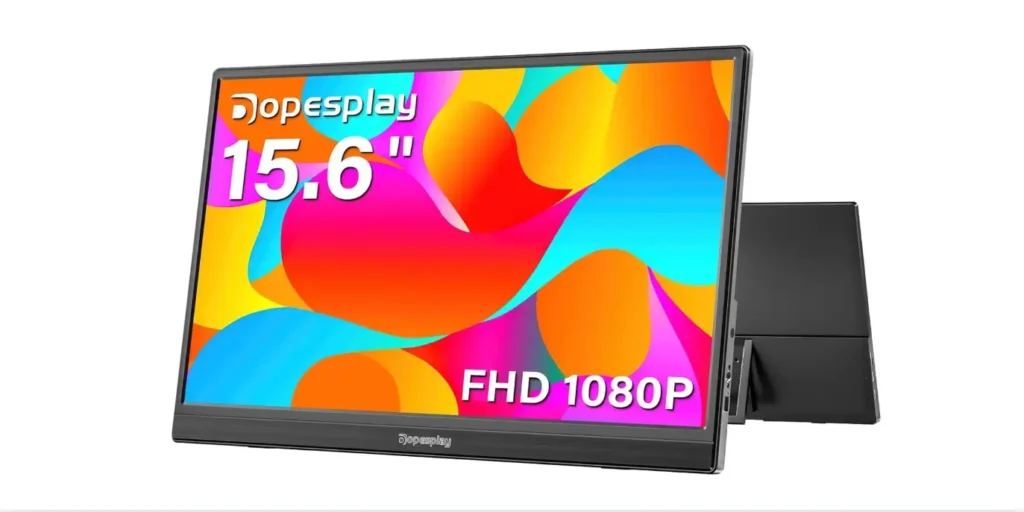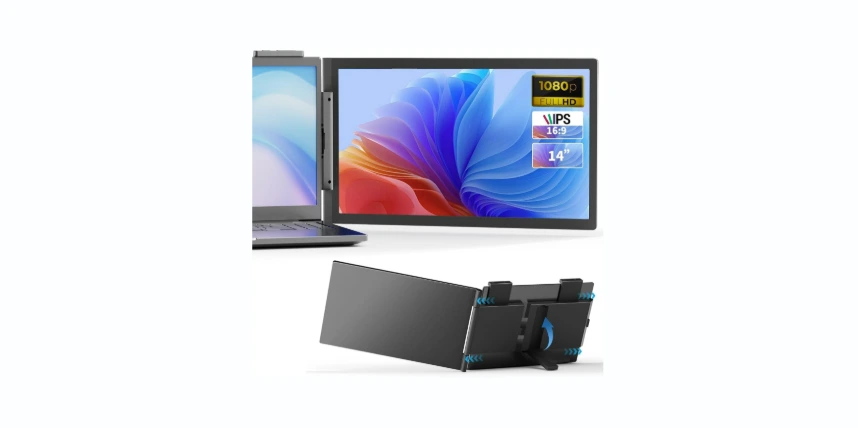Have we ever wished our laptop could sprout a second screen without sprouting a hernia?
Why We Wanted a Laptop Screen Extender
There comes a point in every road warrior’s life when we are forced to choose between tabs and our sanity. We can juggle windows, resize sidebars, and pretend to remember what’s hidden behind that Slack notification, but eventually we start fantasizing about a second display. That’s where the Laptop Screen Extender Dual Monitor – 15.6″ Portable Monitor Detachable IPS 1080P FHD steps in and says, “Let’s stop pretending.”
We were drawn to it not just because it’s portable, but because it is that rare, useful shape-shifter: a detachable display that works as a side-mounted extender or as a standalone portable monitor. Being able to shift identities is a quality we admire in both technology and relatives at holiday dinners.
Our Everyday Chaos (and How This Helps)
On the road, we want simplicity. One screen for the document, one for the reference material, one for cat videos as a reward for not crying in a public restroom. With a 15.6-inch second display, we can spread out properly. We stop toggling like a casino dealer and start working like a person who has seen sunlight before.
The right portable screen gives us more than space; it gives momentum. Emails get answered faster. Comparisons get easier. We even become brave enough to open that spreadsheet with three tabs called “Final,” “Final2,” and “FinalRealFinal.”
Unboxing and First Impressions
Out of the box, this monitor gives us one-clear-message design: it wants to be two things. It attaches to a laptop with its bracket for the classic dual-screen embrace, or it sheds the bracket and becomes a single, freestanding monitor using the included stand. A bit like wearing a sweater that doubles as a scarf, except this one shows 1080p spreadsheets.
The build is modern and tidy, with a transparent back cover that shows some of its innards in a way that says “we’re not trying to hide anything” and “we like neon more than we should.” The colorful breathing lights are a quirky touch. They won’t win us a promotion, but they will make that 7 p.m. PowerPoint review feel less like a minor tragedy.
The Detachable Design That Plays Two Roles
That detachable identity is the star. Snapped to the laptop, it feels like a cohesive dual-screen system. Detached, it becomes a portable 15.6-inch monitor we can prop up next to anything—our laptop, a gaming console, a phone running DeX, or even a truly ambitious knitting pattern.
It’s satisfying to have the choice. Sometimes we need a wing. Sometimes we need a satellite. This gives us both without requiring a backpack that could double as a flotation device.
A Transparent Back Cover and Lights We Didn’t Know We Wanted
A clear back cover seems like one of those flourishes we’ll dismiss and then secretly enjoy. We can see the guts of the device, and the little breathing lights pulse like a calm robot who’s proud of our progress. If we’re in a serious boardroom, we can position the light show out of the way. If we’re at home or in a café, we might let it glow and pretend our productivity has RGB.
Specs That Matter (and Why We Care)
Numbers are only as good as the comfort they buy us. In this case, the headliners are a 15.6-inch IPS panel at 1920×1080 resolution, 85% NTSC color gamut, 300 nits brightness, and a 1000:1 contrast ratio. Translation: crisp text, solid color coverage for general work, enough brightness for most indoor spaces, and contrast that helps text pop without creating inky black holes.
The 3-side narrow bezel gives us a higher screen-to-body ratio—good for immersion, good for packing, and good for our mood when we stare at this thing for six hours straight.
Quick Specs and What They Mean in Real Life
Here’s the rundown, with plain-English context for how it helped us.
| Feature | Details | What It Means for Us |
|---|---|---|
| Screen Size | 15.6 inches | A real workspace, not a tiny appendage; large enough for side-by-side documents. |
| Resolution | 1920×1080 (FHD) | Text looks clean; videos look sharp; easy scaling across Windows/macOS. |
| Panel Type | IPS | Good viewing angles; colors stay consistent when we shift in our seat. |
| Color Gamut | 85% NTSC | Solid coverage for productivity and light creative work. |
| Brightness | 300 nits | Bright enough for offices and cafés; outdoor patio at noon is still a stretch. |
| Contrast Ratio | 1000:1 | Text is punchy; photos have decent depth. |
| Bezel | 3-side narrow | More screen, less frame; helps the dual-screen setup look unified. |
| Weight (folded as extender) | 2.86 lbs | Travel-friendly; won’t anchor our bag to the floor. |
| Weight (detached single screen) | 1.46 lbs | Light enough to carry solo with our laptop. |
| Modes | Extended, Duplicated, Portrait; landscape or vertical | Flexible layouts for multitasking and reading. |
| Auto-Rotate | No | We set orientation manually in the OS; not a dealbreaker. |
| Ports | TYPE-C1/C2 for full-featured USB-C; “USB-C with DP” accepts HDMI-to-USB-C video; power via USB-C | The USB-C route is simple; HDMI requires video cable plus a USB cable for power. |
| Compatibility | Windows, macOS, Linux, ChromeOS, Samsung DeX, Switch, Xbox | A wide net; easy to plug into different ecosystems. |
| Laptop Fit | 13–17 inches | Most mainstream sizes are covered; ultrathin machines still feel balanced. |
| Design | Detachable bracket + stand; transparent back cover; colorful breathing lights | One device, two personalities, with a bit of style. |
What 15.6 Inches Actually Means on the Road
Many portable monitors stop at 13.3 inches, which is polite but not generous. At 15.6 inches, the canvas feels big enough to run a full app without squishing it into the size of a Post-it. We can park a browser on the extender, a doc on the laptop, and stop squinting at twelve-point paragraphs that feel like a test of character.
It’s the difference between glancing and seeing. We didn’t realize how deeply we had adapted to cramped screens until we stopped.
IPS 1080P, 85% NTSC, 300 Nits, 1000:1—Plain-English
In regular use, we get consistent color even when we lean, which we do more as the day progresses. The brightness holds up in a well-lit room and most cafés. If we’re in direct sun, nothing short of a lighthouse will save us, but indoors we’re comfortably productive.
Colors feel balanced out of the box, and while we wouldn’t grade a film on it, we’d happily edit photos for a blog post, social media, or a team share. Text is crisp enough to breeze through long reading sessions without slowly morphing into a gargoyle.
Setup: Truly Plug-and-Play?
Yes, and also a little “some assembly of cables required” depending on our ports. The dream scenario is a laptop with a full-featured USB-C port (Thunderbolt 3/4 or USB-C with DisplayPort Alt Mode). In that case, one cable can send power and video for true plug-and-play.
If we’re working with HDMI, we’ll still be fine—just bring the right cables. HDMI will carry the video to the monitor’s “USB-C with DP” port, and a USB-A/C to USB-C cable powers the screen through one of the TYPE-C1/C2 ports. No drivers. No pop-up wizards. No bargains with the universe.
USB-C Simplicity We Appreciate
When our laptop supports full-featured USB-C, it’s a one-cable kind of day. We plug into TYPE-C1 or TYPE-C2, and the screen lights up with our desktop. It’s a small moment of joy, like finding a spare charger in our bag or getting the last pastry that isn’t sad.
It also makes the desk less chaotic, which makes our brain less chaotic. That’s a two-for-one we won’t turn down.
HDMI with Power: The Two-Cable Dance
If USB-C video isn’t an option, the steps are simple:
- HDMI from the laptop to the monitor’s “USB-C with DP” port via an HDMI-to-USB-C cable (often included with these types of kits).
- Power to the screen via a USB-A or USB-C cable into TYPE-C1 or TYPE-C2.
We kept a compact USB power adapter in the bag for times when our laptop’s ports are spoken for. It’s not mandatory if our laptop can supply enough power, but it keeps things stable, especially with older machines.
Orientation: The One Setting We Must Change Manually
One thing to know: the display won’t auto-rotate when we flip it vertical. We set the orientation ourselves in our OS:
- Windows: Settings > System > Display > Display orientation.
- macOS: System Settings > Displays > Rotation.
- Linux: Varies; we’ve used xrandr or the desktop environment UI.
- ChromeOS: Settings > Device > Displays > Orientation.
It’s hardly a chore, and once we lock the habit, it takes about five seconds.
Modes and Multitasking
This monitor speaks fluent productivity. It handles Extended mode for extra workspace, Duplicate mode for showing others what we’re seeing, and Portrait mode when our work calls for long vertical pages.
We were pleasantly surprised by how steady it feels in vertical use. Toggling between vertical and horizontal changes the mood entirely. Landscape is a second desk. Portrait is a newspaper column. Together, they cover our bases.
Extended, Duplicated, Portrait
Extended is the default for anyone trying to manage more than one window. Duplicate is our comfort zone for impromptu showing-and-telling with a colleague. And Portrait turns long documents from “scroll all the time” into “scroll occasionally, with grace.”
With that trio, we solved 95% of our mobile setups. For the other 5%, we used snacks.
Landscape vs. Vertical: When to Use Which
- Landscape: spreadsheets, timelines, video editing rough cuts, presentation building, side-by-side comparison.
- Vertical: reading research, code reviews, chat threads and email, blog posts, contracts.
We rotated depending on the day. It felt like using both sides of our brain, but with fewer feelings involved.
Compatibility and Use Cases
This display doesn’t play favorites. We used it with Windows, macOS, Linux, and ChromeOS, and it’s game to pair with a Nintendo Switch or Xbox too. It’s also friendly with Samsung DeX, which means our phone can grow up and become a miniature computer at a moment’s notice.
In practical terms, that means we can carry one screen for multiple gadgets. Our laptop, our phone, and our side hustle all get the same second display.
Windows, macOS, Linux, ChromeOS
Each OS recognized the monitor quickly. We adjusted scaling once and got on with our lives. On Windows, 100% or 125% scaling worked best. On macOS, it slotted in nicely with default scaling for 1080p. Linux was cooperative after we nudged the display settings, and ChromeOS did its usual “we got this” thing.
We appreciated how unceremonious it felt. No driver disc. No head-scratching. Just a reliable second screen.
Consoles and Controllers: Switch and Xbox
With HDMI in the mix, it’s easy to use this as a travel console display. We popped the Switch in, powered the monitor via USB, and promptly gifted ourselves a few rounds of Mario Kart between flights. It’s not marketed as a gaming monitor, but for casual play, it’s perfect.
On Xbox, it shined as a compact, crisp display for hotels or dorms. We aren’t trying to host tournaments in a kitchenette, but it’s awfully nice to unwind with a controller instead of refreshing email.
Samsung DeX and Phone-as-PC
DeX support is surprisingly helpful. We plugged in a Galaxy phone, set the monitor on its stand, added a Bluetooth keyboard and mouse, and had a legitimate mini workstation. For quick email triage, drafting notes, and browsing documents, it felt like a magic trick we actually used.
Ergonomics and Everyday Comfort
If a second screen forces our neck into parenthesis, we won’t use it. The 15.6-inch size and adjustable positioning kept things comfortable. On a table, we set the extender at the same height as the laptop, or we used the stand to match eye lines.
We also found 300 nits plenty bright. Indoors, we dialed it down to avoid glowing like a lantern. Out in the wild, we nudged it back up. Our eyes did not complain, which, frankly, feels like a win.
Stand, Bracket, and Stability Across 13–17 Inch Laptops
Compatibility across 13–17 inch laptops means most of us are covered. The bracket system secures the monitor sensibly; it doesn’t wobble like a loose tooth. On thinner ultrabooks, we still felt balanced. On chunkier machines, it looked right at home.
We did pay attention to hinge strength. If our laptop hinge is already weak from years of yawning open, adding any extender will amplify the issue. Ours held up fine, but it’s worth a quick test at home before trying it on a crowded train.
Picture Quality in Practice
Put simply, it’s a pleasant screen to look at. Text is comfortable; icons don’t blur; colors have pep without wandering into neon territory. The panel’s consistency means moving apps between devices isn’t a guessing game—what we see on the extender resembles what we see on our laptop, so we can trust it.
We wouldn’t use it as our only screen for color-critical tasks, but for documents, browsers, meetings, and casual editing? It’s right in the sweet spot.
Color and Contrast
The 85% NTSC coverage earns its keep. We get a robust palette that keeps images from looking washed out. The 1000:1 contrast ratio grants text nice snap, making long reading sessions possible without feeling like we just finished a tiny-font bootcamp.
Colors feel stable across angles, so if we shift our chair or lean in to focus, the image doesn’t turn moody.
Text Clarity and Scaling
At 1080p, text is crisp at normal distances. We favored default scaling on macOS and Windows, then slowly ratcheted down when we felt brave or had a larger physical setup. The practical result: reading without squinting, and the sense that we’re getting the most we can out of the 15.6 inches.
Video Playback and Casual Gaming
Videos run smoothly; motion is clean for streaming and work presentations. Casual gaming looks great, especially from consoles or cloud services. We’re not using it as a competitive e-sports platform, but when we want to pretend a layover is a choice, it does the trick.
Portability and Durability
At 2.86 pounds folded as an extender or 1.46 pounds as a standalone monitor, it earns its place in our travel bag. It doesn’t feel like we just added an anvil to our day. The slim profile helps it share a sleeve with a keyboard or notebook without drama.
We treated it like we treat our laptop—firmly but kindly. It held up to commutes and backpack shuffles without showing scuffs or warping. The transparent back cover somehow made us more attentive, as if the monitor was looking back and rooting for us.
Airports, Conference Rooms, Couch: How It Travels
We tested it through domestic flights, conference rooms with suspicious chairs, and a couch whose cushions had aspirations of swallowing remotes. Every time we set it up, it felt familiar. The bracket made quick laptop installs, and the stand gave us flexibility in tighter spaces.
Travel is full of compromises; we prefer not to compromise on workspace. This monitor makes that a reasonable stance.
Battery and Power Draw Considerations
Any second screen will ask for power, and our laptop battery will feel it. A full-featured USB-C port usually powered the screen fine, but on older laptops or when using HDMI, we fed the monitor with an extra USB power source to keep things stable. A small USB-C power adapter is cheap insurance in that regard.
If we work off-grid for long stretches, we plan accordingly—carry a battery bank or sit near outlets, the office safari of modern life.
The Bracket vs. Stand: Two Personalities
We keep coming back to this dual nature. The bracket creates a tidy dual-monitor laptop rig that behaves like a single unit. The stand offers a flexible second screen we can angle or position wherever we like.
It’s like having two versions of ourselves: one who likes everything neat and attached, and one who enjoys moving pieces around until it feels just right.
Attached Dual Monitor Experience
Mounted to the laptop, the monitor feels surprisingly cohesive. Windows fill the space; the bezel lines up nicely with the laptop display; we forget it’s two pieces. That ergonomic continuity is a big reason we reached for the bracket more than we expected.
We recommend a gentle hand when opening and closing the laptop with it attached, as one does with any hinged accessory. It’s sturdy, but kindness goes a long way.
Single-Screen Freestanding Monitor
On the stand, it becomes a versatile external screen we can place just so. We put our main focus app on the laptop and our references, notes, or chat on the stand-mounted display. In a small workspace, the stand sometimes makes more sense because we can angle it away from prying eyes or adjust for camera positioning on video calls.
Workflows That Shine
We discovered the moments where a second screen feels less like a luxury and more like oxygen. Once we found those, we stopped apologizing for needing one.
Coding, Spreadsheets, Research
Code on one side, logs or documentation on the other. Spreadsheet on one side, reference data on the other. Research on one side, summary on the other. It’s a rhythm: read, write, compare, repeat. The 15.6-inch size lets us keep a full column count visible without zooming to ant-sized cells.
Creative Work and Light Color Tasks
We’re not grading print proofs, but we are cropping, color-correcting lightly, and drafting layout ideas. The monitor handled blog images and social posts well, and the expanded desk made our workflow less fussy. It’s amazing how much better editing feels when our tools are not stacked like pancakes.
Meetings and Calls
We kept chat and video calls up on one screen and notes on the other. We were able to nod thoughtfully without losing the document we were just referencing. If we had a nickel for every time we said “let me pull that up” and meant it literally, we’d have a small jar of nickels and fewer awkward pauses.
Small Quirks Worth Knowing
No product is perfect, and this one doesn’t pretend. We ran into a few small quirks that are easy to work around once we know them.
Cable Reach and Port Placement
Depending on our laptop layout, one port might be awkwardly far. Keeping a slightly longer USB-C or HDMI cable saved us from acrobatics. We also embraced velcro ties, the unsung heroes of tidy tech.
Lid Closing and Sleep Behavior
We recommend undocking or turning off the monitor before slamming the laptop shut. Most laptops manage the external display gracefully, but once in a while, the OS throws a little tantrum. Giving it an extra second or two avoided this.
Bezel and Window Management
The slim bezels look good, but moving windows between displays with different sizes can still feel like a trust fall. We used OS window snapping tools to speed up alignment—now it’s muscle memory, and our shoulders relaxed.
Troubleshooting Tips
Nothing spoils a good coffee like a silent screen. If we run into speed bumps, here’s what helped us get back on track.
Nothing Shows Up
- Check the input route: USB-C with DP Alt Mode or HDMI-to-USB-C plus USB power.
- On Windows/macOS, open display settings and “Detect” the display.
- Try the other USB-C port (TYPE-C1 or TYPE-C2).
- Confirm the cable supports video; not all USB-C cables do.
It Powers On but Says No Signal
- Verify HDMI path: the HDMI-to-USB-C cable should go to the monitor’s “USB-C with DP” labeled port.
- Make sure the monitor has power via the other USB-C port.
- Toggle the input if there’s a selector; some units accept multiple inputs and need a nudge.
Orientation and Scaling Look Wrong
- Set display orientation manually in OS settings when flipping vertical.
- Adjust scaling: on Windows, try 100–125%; on macOS, use “Default” for display.
- Arrange displays so the cursor flows logically (left/right/top) in the OS layout.
Flicker or Power Instability
- Provide dedicated power to the monitor via USB-C when using HDMI.
- Use a higher-quality cable; longer or thin cables can cause issues.
- Try a different USB port on the laptop or a wall adapter for steady power.
Pros and Cons
We like lists because they make decisions feel like math.
Pros:
- Two-in-one design: side-mounted extender or standalone monitor with a single screen stand.
- Big 15.6-inch IPS 1080p panel with narrow bezels and 85% NTSC color coverage.
- Plug-and-play over full-featured USB-C; works with HDMI plus USB power.
- Multiple display modes including portrait, extended, and duplicate.
- Wide compatibility: Windows, macOS, Linux, ChromeOS, Switch, Xbox, Samsung DeX.
- Transparent back cover and colorful breathing lights for personality.
- Actual portability: 2.86 lbs as extender, 1.46 lbs as a single screen.
- No drivers needed; quick setup in most environments.
Cons:
- No auto-rotation; we set orientation in the OS manually.
- Brightness is strong for indoors but not made for bright outdoor sun.
- Using HDMI requires a second cable for power.
- Laptop hinges already on the decline might feel extra stress with any attached extender.
- It’s not a color-critical screen for professional grading.
Who This Is For (and Who It Isn’t)
Life is easier when we know our crowd.
Great Fit
- Mobile professionals who need a reliable, larger second screen on the go.
- Students and researchers juggling references, notes, and video calls.
- Creators working on light photo/video tasks and content planning.
- Console owners who want a crisp travel display.
- Anyone who uses Samsung DeX or wants a second screen for a Chromebook.
- Remote workers who hop between home, office, and coffee shops.
Not Ideal For
- Outdoor-only setups in direct sunlight.
- Color-critical professionals who need calibrated, high-gamut monitors with hardware LUTs.
- Minimalists who believe two screens are an ethical dilemma.
Care and Maintenance
This is a relationship built on gentle habits. Cleaning the screen with a microfiber cloth keeps smudges in their lane. A spritz of screen-safe cleaner (no ammonia, please) and an easy wipe does the trick.
We watched the ports with affection; repeated plugging and unplugging is the nature of portable monitors. We avoided forcing the connectors and kept dust caps or a pouch handy to keep things neat.
Protecting the Ports and Cables
- Use cables with strain relief when possible.
- Avoid tight bends near the connector.
- Carry a slim pouch with spare cables and a tiny USB-C power adapter.
Future-us is grateful when present-us packs thoughtfully.
Environmental and Workspace Considerations
We’ve been known to set up in places where plates outnumber outlets. In cafés and shared spaces, a tidy two-cable setup reads as courteous. The stand helps angle the screen to keep our neighbors from becoming uninvited collaborators.
In meetings, Duplicate mode with the standalone stand lets us present to a small group without hogging the conference screen or fighting with an ancient projector. Sometimes the simplest solution is the one we actually carry with us.
Small Desks, Big Energy
Small desks are tight, but the narrow bezel and flexible stand positioning help. We kept the laptop and monitor in a shallow V-shape to reduce the footprint, and that cleared space for a notebook and a half-decent cup of something caffeinated.
Value and What We’re Paying For
We’re paying for versatility and visual comfort. The two-in-one form means we get both a side-mounted extender and a freestanding monitor without buying two devices. The 15.6-inch size lands in the sweet spot for actual work without scaring our backpack.
We also appreciate the wide compatibility across operating systems and consoles. This single screen earns its keep by working with whatever gadget we have on hand that day.
Support and Peace of Mind
For questions before or after purchase, we can reach out to the seller’s support through the “BKVOO” page. We like having a direct line when we’re checking laptop port compatibility or trying to source an extra cable. The best support experiences are the ones we barely remember because they were short, useful, and mildly uneventful.
A Day in Our Life With It
A typical day: we set up at a coworking desk. USB-C from laptop to TYPE-C1, and we’re live. Slack and calendar on the extender, document on the laptop. After lunch, we flip the monitor to portrait, rotate in settings, and skim a long report without losing our place every three inches.
In the afternoon, a teammate stops by, and we switch to Duplicate mode for a five-minute review. Later, at home, we detach the bracket, use the stand, and plug in a console for a well-earned break. One screen took on multiple roles without complaint. We did, however, complain about the neighbor’s leaf blower, which is a separate review altogether.
The Intangibles That Grew on Us
We like useful things that don’t hide their personality. The transparent back and lights made us smile more than we expected. The monitor felt more like a little companion than a slab of pixels. That matters on long days where success is measured in the absence of sighs.
And there’s that easy rhythm of plug, arrange, work. No drama, no cables colonizing the desk, no settings gremlins. It got out of the way so our work could take center stage.
What We’d Change If We Could
If we were granted a magic wand, we’d add auto-rotation to make portrait mode a touch more seamless. We’d also package slightly longer cables to accommodate a wider variety of laptop port layouts. But even without those, the experience is strong and the setup is easy once we’ve done it once.
We also wouldn’t mind a soft sleeve in the box for the detached single-screen travel mode, though our existing laptop sleeve worked in a pinch.
Practical Tips to Get the Most Out of It
- Save a custom Display arrangement profile if your OS supports it; restoring setups becomes a click.
- Stash an extra USB-C power adapter in your bag for HDMI days.
- Try portrait mode for email and notes—it’s shockingly calming.
- Use OS window snapping or third-party window managers to speed up your layout.
- Keep one microfiber cloth in the bag; the screen will thank us.
Final Thoughts and Verdict
The Laptop Screen Extender Dual Monitor – 15.6″ Portable Monitor Detachable IPS 1080P FHD hits a sweet harmony of function and flexibility. As a side-mounted extender, it feels like a natural extension of our laptop. As a standalone monitor on its single screen stand, it’s the extra stage we didn’t realize our day needed. The 15.6-inch IPS panel with 85% NTSC color, 300 nits brightness, and a 1000:1 contrast ratio makes text and images feel comfortable for long sessions.
Setup is refreshingly simple: one USB-C cable if our laptop supports full-featured USB-C; HDMI plus USB power if it doesn’t. It plays nicely with Windows, macOS, Linux, ChromeOS, Switch, Xbox, and Samsung DeX. The transparent back cover and colorful breathing lights give it charm, and the 3-side thin bezel makes it feel modern and unobtrusive.
It’s not trying to be a studio-grade color monitor or a yard-sunlight champion. It’s trying to be the best portable, dual-personality second screen for real work and sane travel. On that front, it succeeds with a kind of quiet confidence we appreciate—steady, friendly, and ready to help when the tabs begin to multiply and our patience does not.
If we’ve ever wanted a genuine second display without the commitment of hauling a desktop monitor, this is the one we keep reaching for. It expands our space, calms our workflow, and makes us feel a little more put together than we actually are. And that, in our book, is the definition of a helpful gadget.
Disclosure: As an Amazon Associate, I earn from qualifying purchases.
